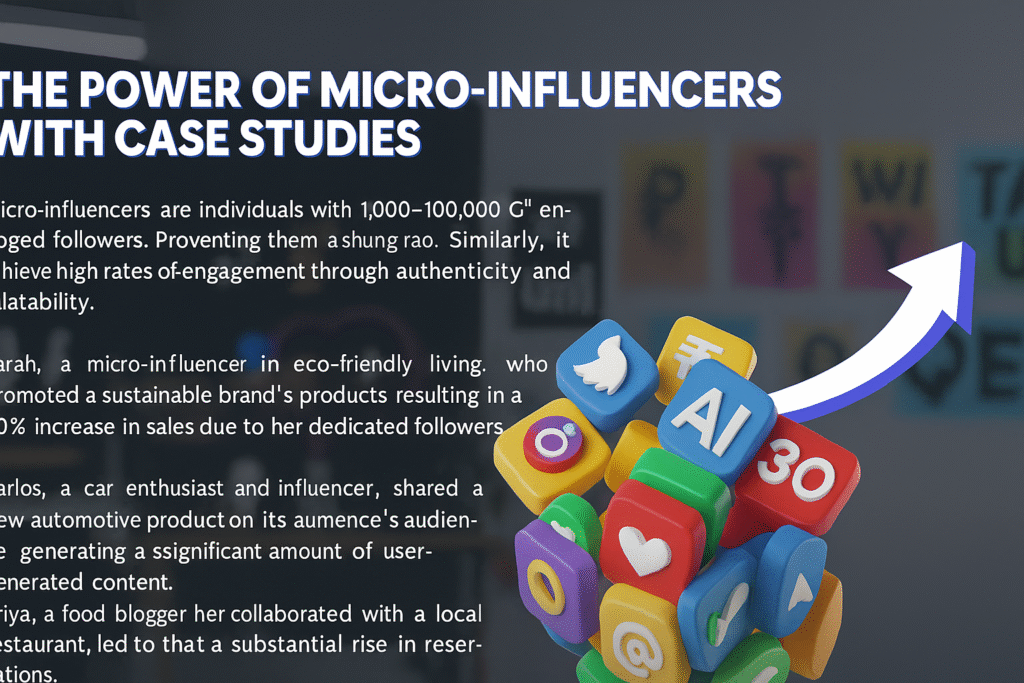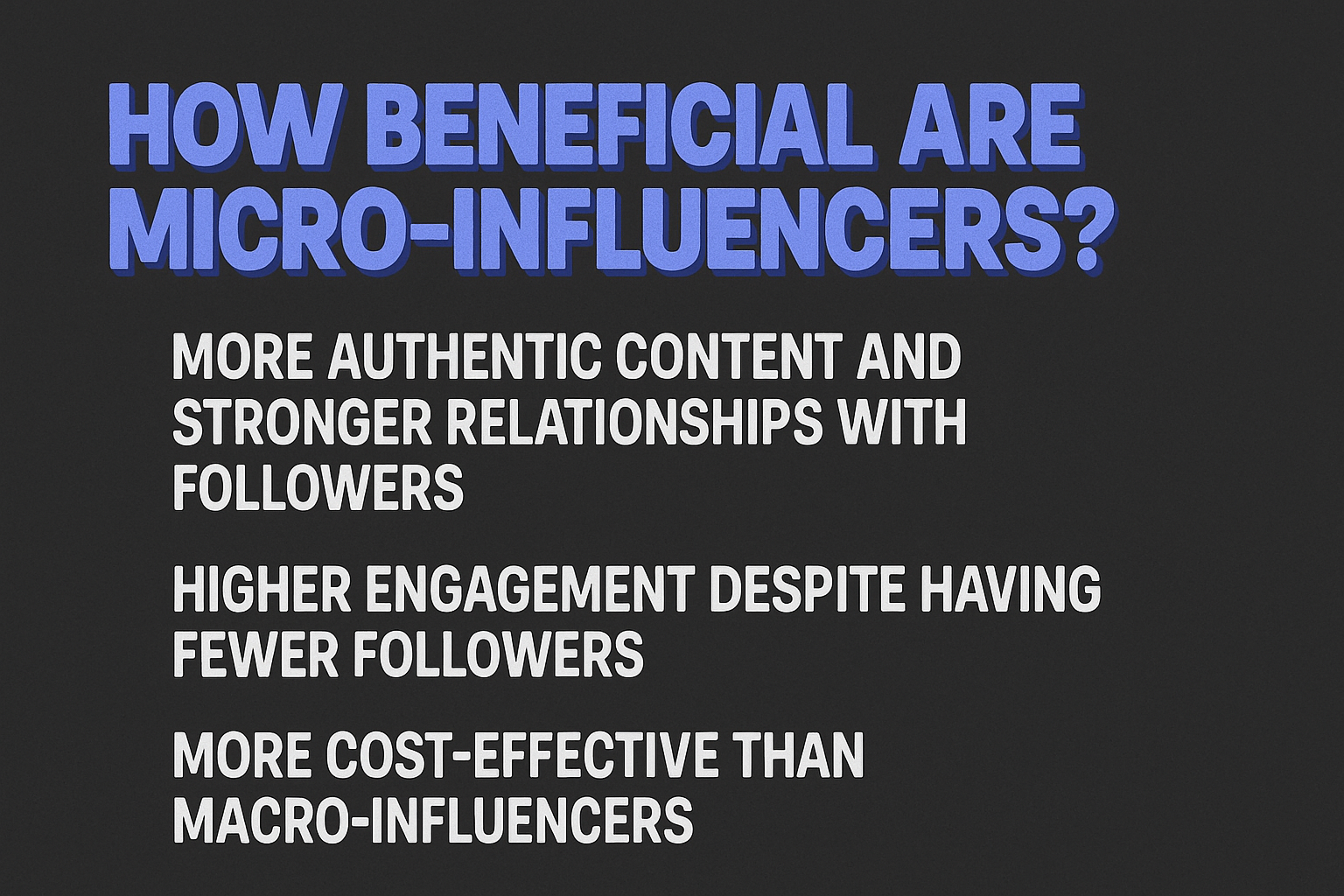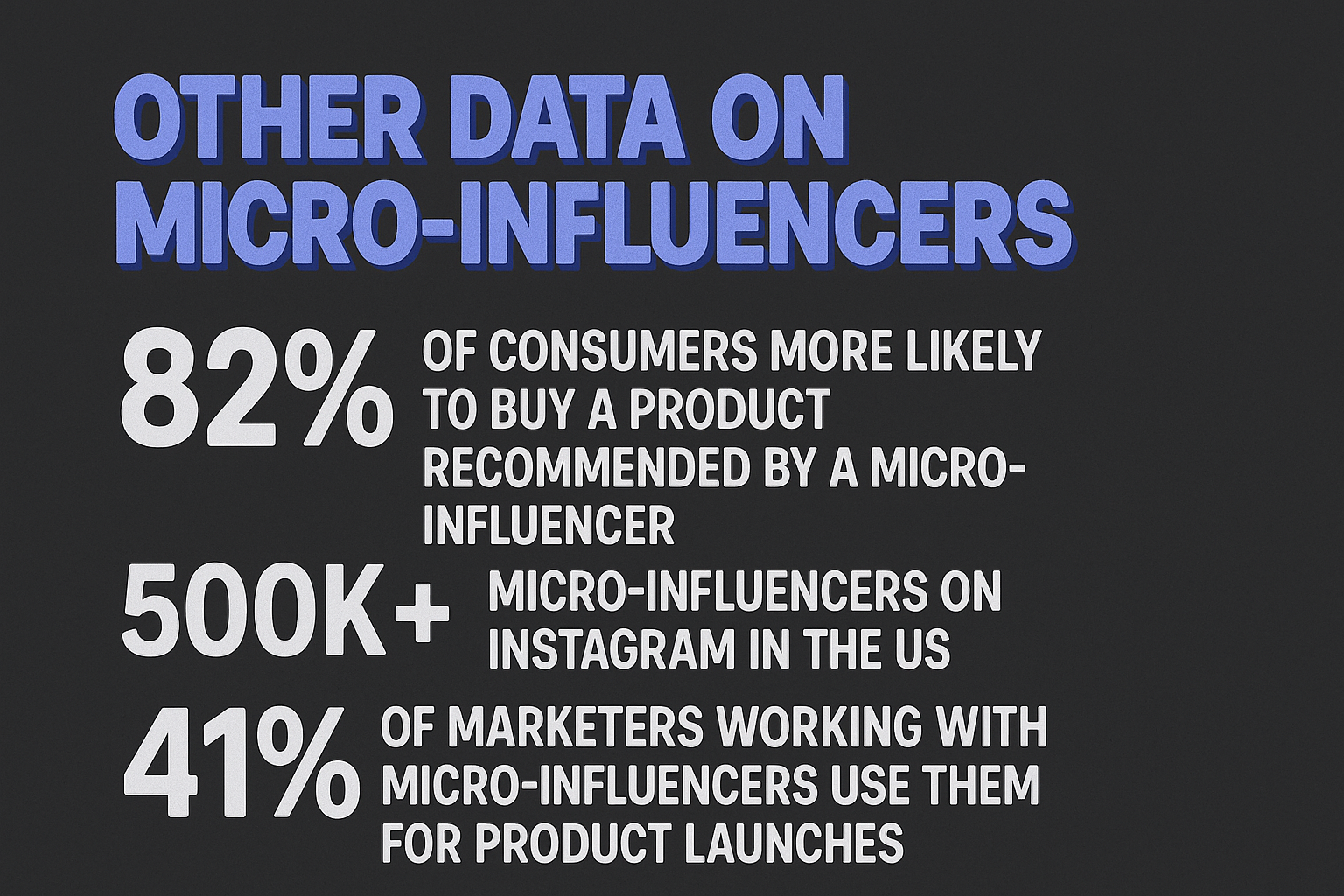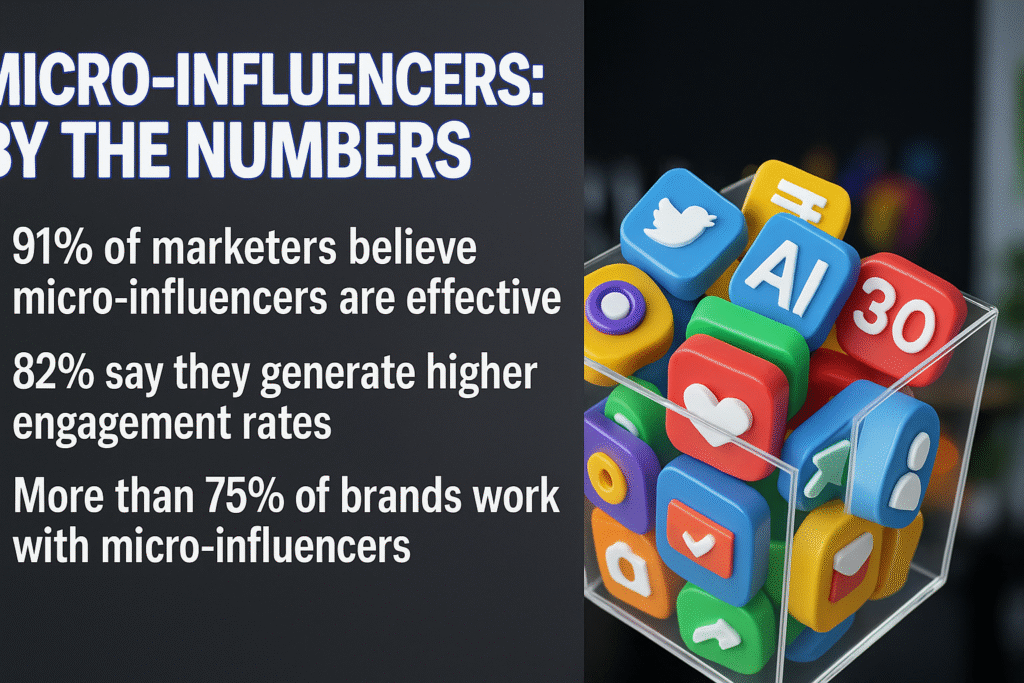Micro-influencer marketing isn’t only popular in 2025; it’s taking over the internet. The game has officially shifted because more than 72% of brands now prefer micro-influencers (those with less than 100K followers) because they are more real and get more engagement. It’s no longer enough to rely on big stars to run campaigns. This article goes into great detail about how micro-influencers are changing brand partnerships, the facts behind their rapid increase, and how you can use them to boost your digital marketing approach, even if you don’t have a big money. Get ready, the influencer gone wild.
The world of influencer marketing has changed a lot, and if you’re still spending a lot of money on macro-influencers, you might be losing out on the actual goldmine. Micro-influencer marketing has gone completely crazy in 2025, giving brands a ROI that has never been seen before and making even the biggest brands reconsider their whole approach.

The Micro-Influencer Revolution → Why Small is the New Big
But here’s where it gets really interesting→ the data shows that it’s not even a fair fight between micro and macro influences anymore.
The Numbers Don’t Lie → Micro-Influencer Performance Stats
Let’s talk about figures since this is where the influencer gone wild phenomenon becomes very clear→
- Average engagement rate→ 10.98% for micro-influencers vs. 1.21% for macro-influencers
- Cost per engagement→ $0.20 for micros vs. $0.33 for macros
- Conversion rates→ 7% for nano/micro vs. 3% for macro-influencers
- Average campaign ROI→ 5→1 to 13→1 for well-executed micro campaigns
Case Study → How Daniel Wellington Made $228 Million with Micro-Influencers
Here’s exactly what they did→
The brand found micro-influencers whose audiences fit their target demographic exactly. Instead of paying enormous sums to macro-influencers, they handed watches to hundreds of smaller producers who actually appreciated the product. The result? An average engagement rate of 7.2% and organic content that seemed natural rather than forced.
The Daniel Wellington Formula→
- Product seeding to suitable micro-influencers
- Simple hashtag strategy (#DanielWellington)
- Reposting user-generated content on brand channels
- Building long-term ambassador ties

The Psychology of Micro-Influencer Success
Understanding why micro-influencers work so well is vital for anyone trying to know how to make money online through influencer collaborations. It all comes down to three psychological elements that macro-influencers simply can’t mimic.
Trust and Relatability
Niche Expertise
Active Community Engagement
Micro vs Macro Influencers → The 2025 ROI Showdown
Let’s break down the micro vs macro influences discussion with hard data since the outcomes could surprise you. While macro-influencers clearly have their place, the ROI comparison offers a compelling story.
| Category | Micro Influencers | Macro Influencers |
|---|---|---|
| Followers | 10K–100K | 500K+ |
| Engagement Rate | High (authentic interaction) | Lower (mass audience) |
| Trust Factor | Strong niche trust | Broad appeal, less personal |
| Content Quality | Relatable, community-driven | Polished, brand-centric |
| Cost per Campaign | Budget-friendly (great for startups) | Expensive (big-brand budgets) |
| Conversion Rate | High ROI (targeted action) | Mid ROI (brand awareness boost) |
| Best For | Product launches, digital products website | Large-scale brand visibility |
| Platform Focus | Instagram, YouTube Shorts, niche blogs | YouTube, X, Instagram (main feed) |
| 2025 Trend | Rising→ paid course free promotions booming | Stable→ great for mass digital marketing |
Cost Effectiveness Analysis
Macro-influencer costs→
- Instagram post→ $5,000-$15,000+
- Average engagement rate→ 1.21%
- Cost per engagement→ $0.33
Micro-influencer costs→
- Instagram post→ $200-$1,000
- Average engagement rate→ 10.98%
- Cost per engagement→ $0.20
Here’s where it gets really fascinating – for the expense of one macro-influencer post, you can work with 5-10 micro-influencers, potentially achieving equal audience numbers but with considerably greater engagement rates.
Conversion Rate Reality Check
The conversion data is where micro-influencers truly shine. Studies constantly reveal that micro-influencers obtain 20% higher conversion rates than their macro counterparts. When nano-influencers (under 10k followers) are added, the conversion advantage climbs to over double that of macro-influencers.
Real-world example→ A beauty business working with 50 micro-influencers (average 15k followers each) saw→
- Total reach→ 750,000 people
- Average engagement→ 8.2%
- Conversion rate→ 5.8%
- Total campaign cost→ $15,000
- Revenue generated→ $87,000
- ROI→ 580%
The Glossier Phenomenon → Community-Driven Micro-Influencer Marketing
No discussion of influencer gone wild success stories is complete without Glossier. This beauty firm turned micro-influencer marketing into an art form, developing a $1.8 billion empire mostly through community-driven techniques.
The ‘Into the Gloss’ Strategy
Glossier’s founder, Emily Weiss, started with a beauty blog called ‘Into the Gloss’ that featured real people talking about their skincare routines. This content attracted a community of beauty enthusiasts who felt heard and respected.
When Glossier began, they possessed something priceless→ a pre-built community of engaged micro-influencers who were already immersed in the brand story.
Making Every Customer an Influencer
Glossier’s clever move was treating every consumer as a potential micro-influencer. They→
- Reposted user-generated content constantly
- Created Instagram-worthy packaging that promoted sharing
- Developed products based on community feedback
- Made their customers feel like co-creators rather than just consumers
Platform-Specific Micro-Influencer Strategies
Different social networks require different approaches to micro influencer marketing, and recognizing these differences can make or break your campaigns.
Instagram → The Visual Storytelling Powerhouse
Winning Instagram strategies→
- Story takeovers for behind-the-scenes content
- IGTV collaborations for longer-form product demonstrations
- Reels partnerships for viral potential
- Feed posts with authentic captions that don’t appear excessively promotional
TikTok → The Authenticity Algorithm
TikTok micro-influencer tactics→
- Product demonstration videos showing real usage
- Trend involvement with brand integration
- Educational content that gives value while highlighting items
- Authentic reviews that address both pros and negatives
YouTube → The Trust-Building Champion
YouTube micro-influencer approaches→
- Detailed product reviews with pros and drawbacks
- Tutorial content using branded products organically
- Vlogs that include products into daily life
- Collaboration videos between complimentary producers

How to Make Money Online → The Creator’s Perspective
Revenue Stream Breakdown→
- Sponsored content (40-60% of income)→
- Brand partnerships and collaborations
- Product placement in regular content
- Campaign-specific posts and stories
- Affiliate marketing (20-30% of income)→
- Commission-based product suggestions
- Long-term collaborations with favorite brands
- Seasonal promotional programs
- Product sales (10-20% of income)→
- Personal items or digital products
- Course production and educational content
- Brand collaborations on co-created products
- Other opportunities (10-15% of income)→
- Speaking engagements and workshops
- Brand consulting services
- Platform creator grants and monetization programs
The Technology Behind Micro-Influencer Success
AI-Powered Influencer Discovery
Modern influencer marketing platforms use artificial intelligence to locate the appropriate micro-influencers for specific projects. These tools analyze→
- Audience demographics and psychographics
- Content themes and brand alignment
- Engagement patterns and authenticity measures
- Historical campaign performance data
Advanced Analytics and Attribution
2025’s micro-influencer initiatives benefit from advanced tracking that measures→
- Multi-touch attribution across the customer lifecycle
- Brand lift and awareness measures
- Long-term customer lifetime value
- Cross-platform engagement tracking
These insights help marketers optimize campaigns in real-time and grasp the true impact of micro-influencer collaborations beyond immediate sales.

Building Your Micro-Influencer Marketing Strategy
Ready to leverage the power of micro influencer marketing for your brand? Here’s a step-by-step technique that successful brands are utilizing in 2025.
Step 1 → Define Your Objectives and Audience
Start with crystal-clear goals→
- Are you focusing on brand exposure, sales, or community building?
- What’s your target demographic and where do they spend time online?
- How will you assess success beyond vanity metrics?
Pro tip→ The most successful micro-influencer campaigns have defined, measurable targets that go beyond ‘increase followers.’
Step 2 → Identify the Right Micro-Influencers
Look for creators who have→
- Genuine involvement (comments, shares, saves)
- Audience alignment with your target demographic
- Content quality that matches your brand aesthetic
- Authentic voice that resonates with their community
Step 3 → Create Authentic Partnership Proposals
Successful partnership outreach includes→
- Personalized messaging that show you’ve actually devoured their material
- Clear value propositions for both parties
- Creative freedom within brand standards
- Fair compensation that acknowledges their time and skills
Step 4 → Scale and Optimize
The magic emerges when you scale successful partnerships→
- Work with numerous micro-influencers simultaneously
- A/B test alternative content kinds and messaging
- Build long-term connections with top performers
- Continuously adjust based on performance data
Avoiding the Pitfalls → When Influencer Marketing Goes Wrong
While influencer gone wild success stories are encouraging, it’s also vital to understand when efforts fail. Learning from these blunders can rescue your brand from pricey calamities.
The Authenticity Trap
Common mistake→ Forcing micro-influencers to use highly promotional language or prepared content.
The result→ Content that feels false and causes bad audience reactions.
The solution→ Give creators creative flexibility within brand standards and trust their grasp of their audience.
The Conversion Obsession
Common mistake→ Focusing primarily on quick sales and ignoring brand-building benefits.
The result→ Short-term thinking that ignores the long-term worth of true brand advocacy.
The solution→ Measure a mix of awareness, engagement, and conversion metrics to identify genuine campaign impact.
The Relationship Neglect
Common mistake→ Treating micro-influencers as one-time suppliers rather than long-term partners.
The result→ Missing possibilities for deeper brand integration and real advocacy.
The solution→ Invest in relationship building and establish continuing cooperation opportunities.

The Future of Micro-Influencer Marketing
As we move forward the rest of 2025 and beyond, numerous trends are defining the future of micro influencer marketing→
Virtual and AI Influencers
While human micro-influencers dominate today, virtual influencers are beginning to carve out niches. However, the authenticity advantage of true micro-influencers predicts they’ll remain dominating in most categories.
Cross-Platform Integration
Successful micro-influencers are becoming platform-agnostic, providing unified brand experiences across Instagram, TikTok, YouTube, and upcoming platforms.
Enhanced Creator Economy Tools
Platforms are developing better monetization tools for artists, making it easier for companies to construct fair, sustainable agreements with micro-influencers.
Community-Driven Commerce
The barrier between content and commerce continues to blur, with micro-influencers becoming essential drivers of social commerce operations.
Making Big Money with Micro-Influencer Partnerships
The Investment Mindset
Think of micro-influencer marketing as establishing a portfolio of brand ambassadors rather than making one-off advertising investments. The most successful brands are→
- Building ties with artists in their sector
- Investing in long-term partnerships rather than transactional campaigns
- Supporting creator growth and applauding their accomplishment
- Creating win-win outcomes that benefit all parties
Measuring What Matters
Success in micro-influencer marketing demands comprehensive measurement→
- Brand awareness lift in target demographics
- Customer acquisition cost compared to other channels
- Customer lifetime value of influencer-driven consumers
- Organic reach amplification through user-generated content
The brands generating big money recognize that micro-influencer marketing is about developing communities, not just driving instant sales.
Conclusion → The Micro-Influencer Goldmine
For brands ready to grasp this opportunity, the potential is huge. With micro vs macro influencers exhibiting clear advantages in engagement, conversion, and cost-effectiveness, the route forward is apparent.
FAQ’s
- What are Micro Influencers?
Micro influencers are social media providers with a modest but highly engaged audience, generally focused on a specific area like fashion, fitness, tech, or education. They are trusted advocates in their community and frequently feel more relatable than large celebs. - How many followers is a micro influencer?
A micro influencer usually has between 10,000 to 100,000 followers. This range allows them to keep engaged with their audience while yet having reasonable reach for brand collaborations. - How much do micro influencers get paid?
Micro influencers can earn anywhere from ₹2,000 to ₹25,000 each post in India (or $100 to $1,000 internationally). Payment depends on niche, platform (Instagram, YouTube, etc.), interaction rate, and brand budget. - Who is a Micro Influencer Example?
An example is Kritika Khurana (@thatbohogirl) during her early content days—she focused on fashion and lifestyle and created a dedicated community before scaling up. Many now-popular influencers began as micro influencers. - Are micro influencers better?
Yes – they usually deliver higher engagement, better trust, and are more cost-effective than macro influencers. Their opinions feel authentic, which typically leads to improved conversions for brands. - Why are micro influencers important?
Micro influencers are crucial because they help marketers target specialized audiences with true influence and trust. Their content feels like a recommendation from a friend rather than an ad. - How big are micro influencers?
Micro influencers aren’t the biggest in numbers but significant in impact. With 10K to 100K followers, they achieve the perfect blend between personal connection and marketing possibilities.